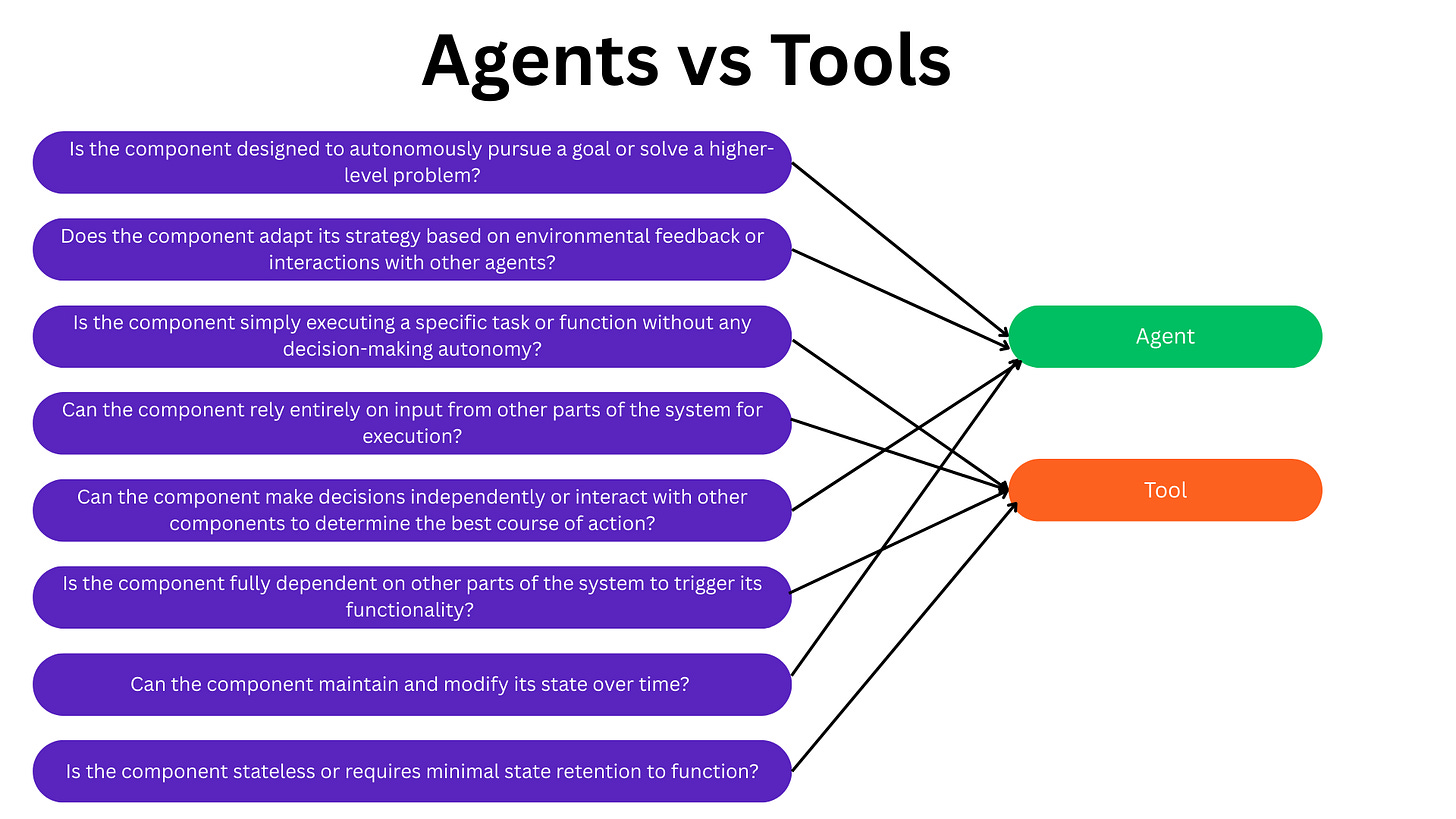Difference between Agents and Tools in Multi-Agent Architecture
Lessons from learning to build a multi-agent application in 7 weeks
When building multi-agent architectures, understanding the distinction between tools and agents is crucial for effective system design and implementation. While both components are essential building blocks of these systems, they serve fundamentally different purposes and operate under distinct paradigms. Understanding their differences is vital for creating efficient, maintainable, and scalable multi-agent systems.
What are Tools?
Tools are specialised components that provide specific functionalities or services that agents can utilise to accomplish their tasks. Unlike agents, tools don't possess autonomy or decision-making capabilities. They are passive resources that respond to requests and execute predefined operations.
Key characteristics of tools include:
Specialised functionality: Tools perform specific, well-defined tasks
Stateless operation: Tools typically don't maintain internal state between operations
Predictable behaviour: Tools produce consistent outputs for given inputs
Passive nature: Tools only act when invoked by agents
Why Tools Matter?
Tools play a crucial role in multi-agent systems for several reasons:
Modularity: Tools enable better system organisation by encapsulating specific functionalities
Reusability: Multiple agents can share and utilise the same tools
Maintenance: Tools can be updated or replaced without affecting agent logic
Efficiency: Specialised tools can optimise common operations
Standardisation: Tools provide consistent interfaces for common functionalities
How to Determine Whether a Component is an Agent Versus Tool?
To differentiate between agents and tools, consider these key differences between them:
Agent Characteristics:
Autonomy: Agents make independent decisions. Agents can evaluate situations and choose appropriate actions without requiring explicit instructions. For example, an agent might automatically adjust its behaviour based on changing environmental conditions.
Proactivity: Agents take initiative without external triggers. Unlike reactive tools, agents can anticipate needs and initiate actions on their own. They might start gathering data or launching processes before being explicitly asked to do so.
State Management: Agents maintain internal state and memory. Agents can remember past interactions, learn from experiences, and use this knowledge to inform future decisions. This enables them to improve their performance over time.
Goal-Oriented: Agents work towards specific objectives. Agents can break down complex goals into subtasks and pursue them systematically. They can also adjust their strategies when encountering obstacles.
Social Ability: Agents communicate and coordinate with other agents. This includes negotiating resources, sharing information, and collaborating on complex tasks. Agents can form dynamic partnerships to achieve goals that would be difficult to accomplish alone.
Tool Characteristics:
Reactive: Tools only respond to specific requests. For example, a database query tool will only execute when explicitly called and won't perform operations on its own. This reactive nature makes tools predictable and easier to control.
Function-Oriented: Tools perform specific, predefined tasks. Like a calculator that performs mathematical operations or a text parser that follows set rules, tools are designed with clear, limited scope. This focused design ensures reliability and efficiency in their specific domain.
Stateless: Tools don't maintain internal state between operations. Each request is processed independently, similar to how a REST API handles requests without remembering previous interactions. This makes tools more reliable and easier to debug.
Deterministic: Tools produce consistent outputs for given inputs. Given the same parameters, a tool will always return the same result, much like how a sorting algorithm will always arrange items in the same order. This predictability is crucial for system reliability.
When designing a component, ask these questions to determine whether you should design a component as an agent vs a tool:
Example: Building a multi-agent technical paper reading application
Thinking deeply about the tools vs agents in my multi-agent architecture, I am thinking of demarcating tools vs agents as below.
Agents that specialise in:
Document Parsing and Structuring: An agent to take the raw paper (likely PDF or similar) and break it down into its constituent sections (abstract, introduction, methodology, results, etc.).
Information Extraction: Agents focused on identifying key entities, concepts, definitions, and relationships within each section. This could involve techniques like Named Entity Recognition, Relation Extraction, and potentially even topic modelling.
Knowledge Graph Construction: An agent to take the extracted information and build a structured knowledge graph representing the paper's content. This graph would form the basis of your mind map.
Mind Map Generation and Interactivity: An agent responsible for visualising the knowledge graph as an interactive mind map, allowing users to zoom, expand nodes, and explore connections.
Explanation and Simplification (Potentially): Depending on the complexity, you might even consider agents that can generate simplified explanations for certain technical terms or concepts when a user clicks on a specific node.
Tools that perform:
Email Services that can email the created document or mindmap to an intended recipient.
Specialised Databases APIs (e.g., academic databases like arXiv API, PubMed API). An agent focused on a specific domain (like AI research or bioinformatics) could use APIs to access structured information from relevant databases. For example, an agent tracking new AI publications might use the arXiv API.
As I build out the multi-agent application further, I will be updating the list on more tools and redefining of agents that come with it.
This is turning out to be fun!
Next week, let’s talk about the communication patterns through which agents interact.
I am learning to build these multi-agent applications from Maven’s Multi-agent bootcamp by AISC, a great course by Amir and Abhi! Check them out.

